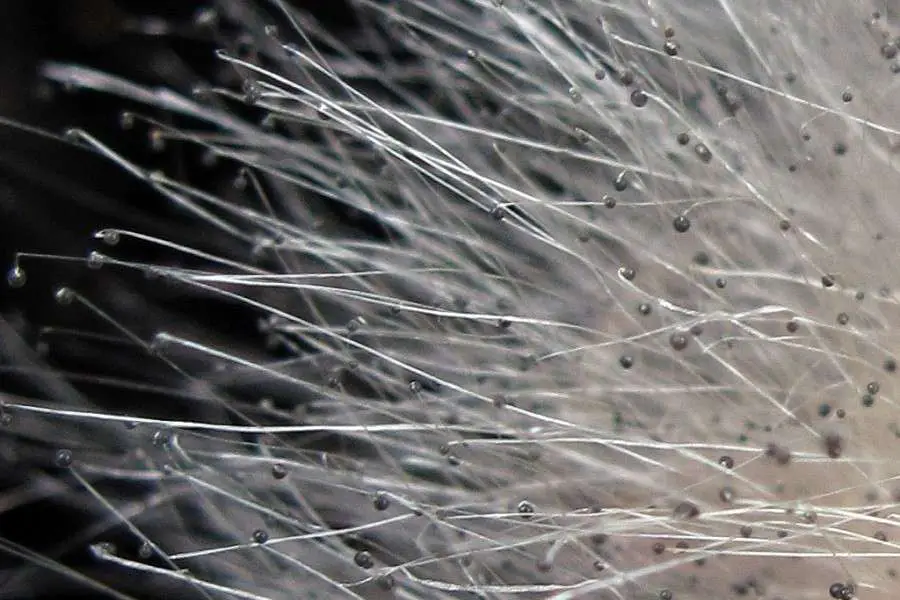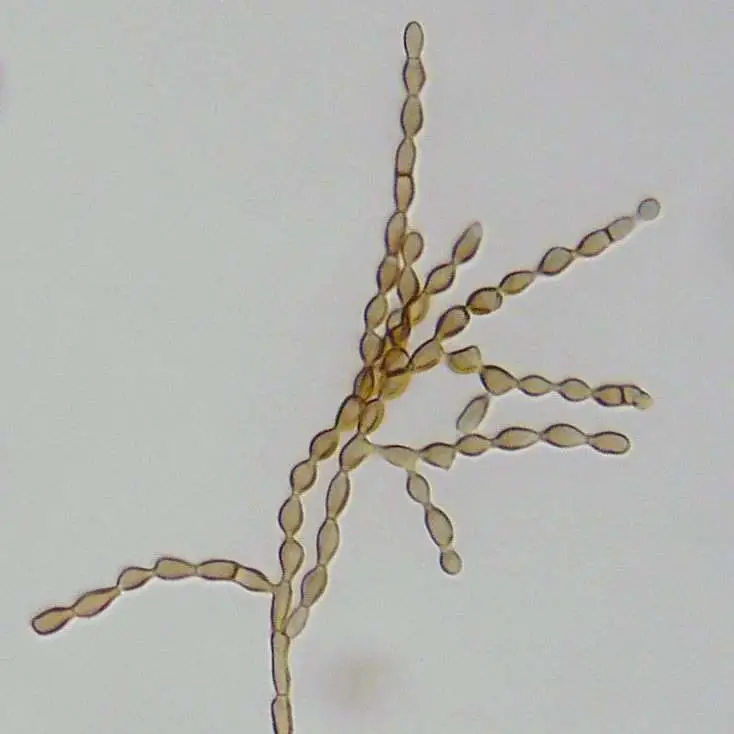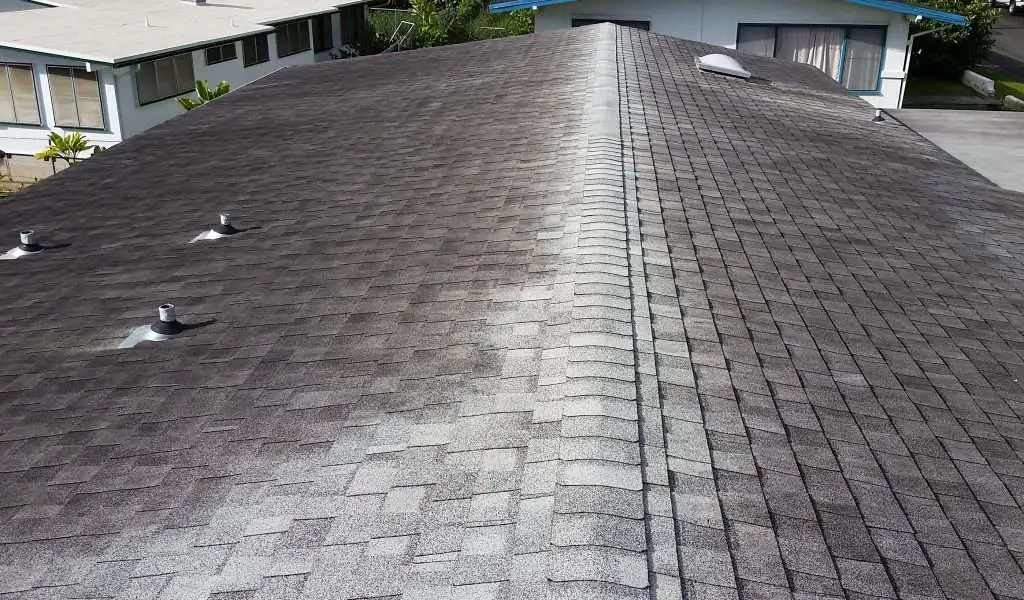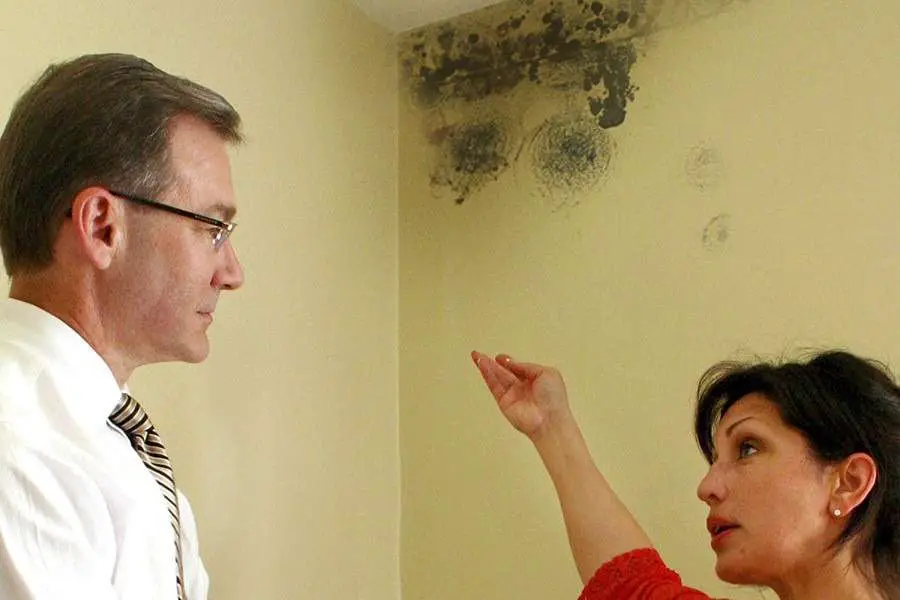A mold is a multi-cellular fungus that usually grows in thread-like filaments known as hyphae. Molds are taxonomically diverse and large groups of fungal species where the growth of hyphae leads to a fuzzy appearance and discoloration, particularly on food.
This branching network of tubular structures of hyphae is known as a mycelium, which is a single organism. In most cases, the hyphae are often transparent; therefore, the appearance of mycelium is similar to extremely fine and white fluffy threads.
A majority of molds have a dusty texture caused by the profuse production of different asexual spores known as conidia. The shape and method of formation of the spores are suitable for the classification of molds. Many spores are usually colored which makes the fungi more apparent to the eyes.

According to studies, molds are microbes that do not tend to form any specific phylogenetic or taxonomic grouping. However, you can find them in some divisions such as Ascomycota and Zygomycota. Many molds were part of a group called Deuteromycota.
Molds lead to biodegradation of many natural materials, which is unwanted if it causes food spoilage or property damage. Molds also play vital roles in food science and biotechnology, producing a variety of foods, antibiotics, beverages, enzymes, and pharmaceuticals. Specific molds cause many human and animal diseases.
A disease can be caused by an allergic sensitivity to various mold spores, from the bodily growth of certain pathogenic molds, or due to the result of inhaled or ingested toxic compounds called mycotoxins.
Moisture is essential for mold growth. There are various sources of moisture in the home such as cooking, washing, air humidifiers, plumbing leaks, and condensation. In many cases, poor ventilation leads to greater humidity levels, causing condensation which promotes mold growth. It is for this reason that we always recommend the use of a suitable dehumidifier.
Different Types Of Mold Found In Homes
Here are some common types of mold you are likely to find in your home. It is important to know the different types of mold as it can help you identify the mold types present in the home and take action to get rid of them.
Aspergillus
Aspergillus is one of the most common molds found in many households. Its spores are long and flask-shaped that often form walls or thick layers of mold, which usually leads to long and thick chains of mold growth. As there are more than 185 species of this mold, it may appear in a variety of different colors.
Keep in mind that Aspergillus is a type of allergenic mold; however, it can also become toxic depending on the environment and specific species. It may cause symptoms like lung infections, asthma attacks, and respiratory inflammation. A few species of Aspergillus can produce aflatoxin which is the deadly carcinogen.

The prevalence of Aspergillus in the environment coupled with the ease of cultivation in laboratory settings ensured many industrial microbiologists and mycologists were attracted to study them.
The mold grows abundantly in the form of saprophytes on decaying or decomposing vegetation, and you can find it in extensive numbers in organic compost piles, moldy hay, and leaf litter. A majority of species can degrade complex plant polymers; however, they also often dine on many substrates such as dung, antique parchment, and human tissues.
Exposure to this mold often results in a few minor symptoms in most healthy adults; however, some individuals are at a greater risk of more severe health problems associated with this kind of mold.
These people include the infants, elderly, young kids, and individuals with immune system disorders, asthma, and cystic fibrosis. People recovering from serious surgery or illness are also more prone to risk.
A few grave health complications that may arise from frequent exposure to aspergillus include:
Cladosporium
Cladosporium is also an allergenic mold. The mold is unique as it can grow in both cold and warm temperatures. It usually thrives indoors and is a mold that can be found in fabrics, carpets, and upholsteries. It is also present inside cupboards and under floorboards. Cladosporium has a brown or olive-green color with a suede texture.
The mold has about forty species, which you can find on various decaying plant materials, in the soil, and in plant pathogens.
The concentration of the mold species is quite low during the winter. In contrast, in summers, the concentration is in the range of 2,000 and 50,000 spores for every cubic meter of air. The indoor concentration of the mold depends on indoor growth sources and outdoor concentrations.

Cladosporium can cause a variety of allergic reactions to your nose, eyes, skin, and throat. Exposure to the mold can lead to lesions and skin rash, lung infections, asthma, and sinusitis. Although it does not have toxic properties, it is safer to not handle Cladosporium directly because of its potential to cause lung and skin irritation.
However, bear in mind that people may react differently to the mold at a lower concentration based on the sensitivity. Spores of Cladosporium have branched loose or simple chains and tend to vary considerably in size and shape (oblong, ovoid and spherical).You can easily detect them in spore traps, but be careful as you might mistake single-celled spores for other mold spores.
Cladosporium sphaerospermum is one of the most predominant species of this mold that tends to grow in buildings. Many studies have indicated that this species can easily outgrow penicillium chrysogenum due to its unique ability to reinitiate quick growth from its hyphal tips much quicker compared to Penicillium species.
Keep in mind that Cladosporium sphaerospermum and sometimes Cladosporium herbarium are often isolated from many indoor surfaces like bathrooms, damp painted surfaces, and windowsills. They are also usually found colonizing wood which is where painting over mold can be useful.
Stachybotrys (Black Mold)
Stachybotrys, also called the evil black mold, is a type of toxigenic mold that may cause some allergic reactions. The mold has a black or dark green color with a very slimy texture.
Like other molds, Stachybotrys tends to thrive in wet or damp areas with higher humidity levels, especially when these conditions persist for many weeks. It also flourishes on different cellulose materials such as cardboard, wood, paper, wicker or hay.

Stachybotrys is often toxic as it can produce mycotoxins in large quantities that may lead to serious health issues for people who are exposed to it frequently. Exposure to Stachybotrys can lead to symptoms such as sinusitis, troubled breathing, fatigue, and depression. Pain and dull aching of the mucous membranes are very common among people exposed to black mold.
In case you encounter this mold, you might experience a burning sensation in the airways, persistent cough, tightening in your chest, nosebleeds, painful headaches and fever.
Moreover, Stachybotrys can lead to pulmonary bleeding in infants and neurological problems in kids. Therefore, if you have this mold in your home with infants or kids, it is imperative to get rid of the mold from your home to prevent exposure.
Trichoderma
Trichoderma is a type of allergenic mold and has five subspecies. It has a white color usually with greenish patches. Colonies of Trichoderma mold often overgrow in the form of wooly-textured clusters which become compact with time. It grows in homes on wet and damp surfaces including carpets, wallpapers, and damp fabrics.
The mold flourishes in moist areas; so, you are likely to find it in your AC filters and HVAC ducts where condensation builds up. Although a majority of Trichoderma molds are usually non-pathogenic, a few types can lead to several pulmonary and hepatic infections. When this mold generates mycotoxins, it acts like Stachybotrys.

Also, Trichoderma is very damaging to a lot of building materials. It has a corrosive enzyme that can destroy paper, textile, and wood products, which usually triggers rot, causing these structures to deteriorate and crumble. Therefore, you must deal with a Trichoderma mold infestation professionally to prevent damage to building materials and avert potential health hazards.
Health Effects On The Household
Molds can have various adverse effects on your home. For many people, molds may lead to nasal stuffiness, coughing, throat irritation, wheezing, and skin and eye irritation. Individuals with various mold allergies might experience more severe reactions.
Air Quality
According to experts, the mold is one of the main contributors of poor air quality with the potential to cause serious detrimental effects on your health. According to estimates, on average humans spend up to 90% of their daily life indoors; so, the air quality is essential.
In most cases, the quality of air indoors in many houses and workplaces could be six to ten times more contaminated due to many airborne mold spores compared to the outdoor air. The naked eye can not see a majority of airborne mold spores, and many are odorless too.

This state implies that we inhale mold spores without knowing all the time. Specific health risks often vary depending on the type of mold, amount of mold in the air, length of exposure as well as the person’s sensitivity to mold. Mold inspections with air testing are helpful in determining if airborne mold growth compromises your indoor air quality.
In many public buildings and hospitals, germicidal UV light is successfully used to control spreading of infections, microbial growth and improve indoor air quality. Moreover, UVC light could also help prevent mold problems as it renders airborne mold spores and mold particles non-viable. The light can even sterilize surface mold colonies, provided they are irradiated using germicidal UV light directly.
Coughing And Sneezing
In case you have mold problems in your house, then it is likely you will continually inhale mold spores from the indoor air. These mold spores can trigger many allergic reactions such as sneezing, coughing, and runny nose.
Molds lead to symptoms similar to flu or cold such as coughing and runny nose. Bear in mind that sneezing is a widespread allergic reaction to your immune system when you inhale allergens such as mold spores. Even when you do not have any mold allergy, many mold spores can cause you to sneeze by irritating the throat and nose.

When you inhale mold spores, they can irritate your mucous membranes. In some cases, many mold spores can lodge in your airways and lungs, causing chronic sneezing and coughing.
Decongestants and antihistamines could help relieve these symptoms. It is important to plan carefully and put on a dust mask or take allergy medication to preempt the symptoms if you expect to be near potential mold sources, like when carrying out yard work.
Irritation Of The Eyes
Several kinds of molds may lead to eye problems, including irritation, such as Aspergillus, chaetomium, Stachybotrys chartarum as well as phagophore. Frequent exposure to these molds can lead to various respiratory and allergic reaction symptoms. These include itchy eyes, watery eyes, and redness in the eyes. However, in addition to these minor symptoms, more severe issues may arise, including various eye infections.
Conjunctivitis is a common eye infection which is also called pink eye as it causes a pink or red coloring in the eye. The causes can be viral and bacterial or mold and other irritants or allergens. Symptoms are gritty-feeling or itchy eyes, burning sensations in the eye, profuse discharge from the eye and watery eyes. Often eye drops with corticosteroids are prescribed for the condition.

Keratitis is another eye infection usually caused by molds that can cause eye irritation. It infects the cornea, the delicate and clear tissue covering the pupil and iris. Viruses or molds may cause keratitis. People who wear contact lenses are prone to this infection. Without adequate and prompt treatment, permanent damage may result to the cornea, causing loss of vision.
Mucus Membrane
Many volatile organic compounds enter your body via your respiratory system through inhalation. A few of these compounds are often absorbed by your upper respiratory system, leading to inflammation and irritation.
When you inhale these compounds, they usually trigger irritation of your mucous membranes. Moreover, they may affect your central nervous system too when present in high concentration, which can cause headaches and lack of concentration.
Difference Between Mold And Mildew
Like siblings with similar features, mildew and mold have some matching characteristics. Both thrive in moist and warm regions. They also tend to grow on various surfaces such as your shower and sheets of paper. However, mildew and mold also have a few striking differences in color, size, and texture.
Remember that mildew is a fungus that you can easily identify as a gray or white patch of fungus usually found on moist surfaces. You can easily treat mildew with a scrubbing brush and cleaner. On the other hand, mold could be green or black and is usually a result of extensive infestations. Mold can seem fuzzy or slimy, particularly when found on food.
Mildew often affects crops and plants. However, if it grows indoors, it may pose health risks such as coughing, sore throat, headache, and respiratory problems. In contrast, mold can cause significant structural damage, especially if left unattended for long time periods.
Where You Can Find Mold In Your House
Mold can grow in various places in your home, especially in moist and damp areas with high humidity levels.
Bathrooms
If you think you have never seen mold in your bathroom, it is likely you have not looked deep into all the corners of the bathroom. It is the most common issue in most houses. Bathroom mold often occurs because mold prefers dark, damp and isolated spaces which is why a small dehumidifer you can place in your bathroom is so beneficial.
Usually, a shower, bathtub, or whole bathroom remains sufficiently damp and moist for mold growth due to bathing or showering. A few causes of mold in bathrooms include:
Roof
Roof lichens, algae, or moss can easily eat through the shingles and roof deck and cause wood rot. As a result, moisture seeps in through the fissures and cracks, creating an environment conducive to mold growth. Mold often begins its life cycle in the form of airborne spores that settle on your roof.

The mold spores on the north side of your roof have a greater likelihood of survival as this section of the roof dries last after morning dew or rain. This effect increases the humidity level on the roof surface, creating an ideal breeding and feeding ground for the mold.
Attics
The attic is another area conducive to mold growth. These factors make attics a mold-friendly location:
Car
Your car is also the perfect breeding ground for mold due to a natural build up of moisture and a lack of ventilation. Our guide tells you exactly how to remove mold from your car's interior.
Tips For Mold Prevention
These are a few useful tips for preventing mold in your home:
How To Get Rid Of Mold
In most cases, you can get rid of mold in a few simple steps without resorting to professional help. Follow our step-by-step guide to free your home from nasty mold.
Conclusion
We have discussed what mold is along with its different types such as Aspergillus, Cladosporium, and Stachybotrys. We have highlighted the different health issues associated with these molds. We have also discussed the health effects of mold on households like poor air quality, eye, and skin irritation, and coughing, etc.
We have pointed out some differences between molds and mildew to ease identification. We have also indicated why you usually find molds in places like bathrooms, attics, and roofs.
We have listed a few tips to prevent mold from occurring in your home which emphasize the importance of minimizing dampness and moisture in your home. We have also provided a guide to get rid of mold in a few simple steps. Our buying guide will discuss the different features that you should consider when buying mold cleaners along with some recommendations.

